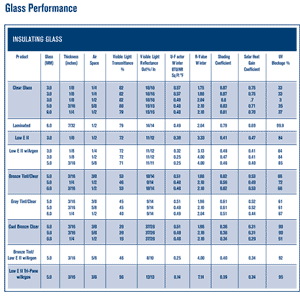Building Green with Windows and Doors
Glazing Technology Makes a Difference
Since the first century AD, when glass was originally made by casting, or blowing hollow cylinders that were slit and flattened into sheets, craftsmen have sought improvements. Having mastered the primary purpose of letting light in, manufacturers now address the many ways of treating glass panels to control the transfer of heat. Commercial glass is made with sand, a raw material in ample supply (the cost to recycle glass is a fraction of the original manufacturing cost). Glass is affected by few chemicals, resists most industrial and food acids, withstands intense heat or cold as well as sudden temperature change and retains heat, rather than conducts it. It also absorbs heat better than metal and strongly resists electric current, while its optical properties include reflecting, bending and absorbing light with great accuracy.
*Clear single pane windows offer the lowest energy efficiency ratings and allow the highest transfer of energy and daylight transmission. Single strength glass is 3/32 inch (2.5 mm) thick.
*Insulating glass offers the next lowest in terms of energy transfer. It features two panes of glass separated by a spacer around the entire perimeter and hermetically sealed together with dead air space between the panes. The spacer contains a moisture-absorbent material called desiccant that serves to keep the enclosed air free of visible condensing material. The dead air space creates an insulating barrier and also helps to reduce sound transmission.
Double strength glass comes in 1/8 inch (3.0 mm), 5/32 inch (4.0 mm) 3/16 inch (5.0 mm) and 1/4 inch (6.0 mm) thicknesses. Structural requirements determine which glass strength is used in a project.
*Warm-edge spacers. The thermally weakest part of any insulating glass system is the edge where the spacer separates the lites of glass. Aluminum spacers are being replaced by warm-edge spacers manufactured from low-conductivity material such as stainless steel, vinyl, butyl-rubber or silicone-foam. They can improve the U-Factor of a window by 10 percent and boost the glass edge temperature by nearly 5°F, thereby helping to reduce condensation.
*Low-Emissivity (low-E) coated glass improves the U-Factor that in turn suppresses heat flow (reflects long wave radiation). It also blocks short wave radiation in order to impede solar heat gain-plus reducing winter condensation because of higher indoor glass temperatures. Low-E coatings are designed to reduce winter heat loss and summer heat gain as well as block harmful ultraviolet rays. They are available in high, medium or low solar gain. High solar gain is best suited for cold climates that need to bring in as much solar heat as possible, while low solar gain is appropriate for warmer climates. Low-E coatings also improve protection of furniture, carpet, and interior finishes from premature fading by lowering the Fading Transmission (Twd).
|
The low-E coating works by reflecting selected portions of the light spectrum out or in through the window. It is applied to one of the inside surfaces of the insulating glass and can block unwanted solar heat gain without blocking as much visible transmittance as tints do.
Evolved from the space program, the coating is a thin microscopic, virtually invisible (today's generation) metal or metallic oxide layer coating typically applied on the surface of the insulating glass.










